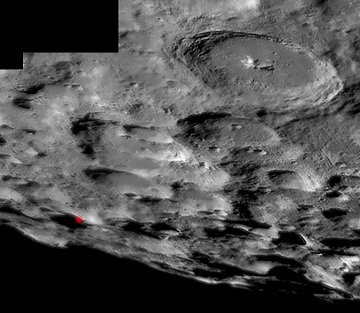| GIANT NEW RING AROUND SATURN: Just when you thought every big thing in the Solar System had already been discovered, NASA's Spitzer Space Telescope has found an extraordinary new "supersized" ring around Saturn. Get the full story from Science@NASA. LUNAR IMPACT: NASA has updated the time of Friday morning's lunar impact. The LCROSS booster rocket will plunge into crater Cabeus at 4:31 am PDT (11:31 UT) followed by the LCROSS mothership four minutes later. Tune into NASA TV for live coverage of the event beginning at 3:15 am PDT (10:15 UT). This morning, amateur astronomer Pete Lawrence photographed the impact site from his backyard observatory in Selsey UK. The red dot marks the spot: 
"I used NASA's pointing chart to find target crater Cabeus," says Lawrence. NASA hopes many amateur astronomers will be watching on Friday. "The more eyes the better," says LCROSS team member Brian Day of NASA/Ames. "We've never done this before and surprises are possible." US sky watchers west of the Mississippi river are favored with darkness and good views of the Moon at the time of the impacts. To observers on Earth, the initial flashes of light marking the destruction of the two spacecraft will be hidden by crater walls. The debris plumes, however, should be visible in 10-inch class telescopes as they rise 10 km high above the rim of Cabeus. Note the shadows behind the red dot in Lawrence's image. The sunlit plumes will be highlighted by that dark backdrop: observing tips. The impacts are designed to excavate frozen water from the cold and shadowy floor of crater Cabeus. Moon water is valuable stuff. It costs about $30,000 to rocket a liter of water from Earth to the Moon. If NASA could find water already on the Moon, it would save a lot of money for future thirsty colonists. H2O also can be split into O2 for breathing and H2 for rocket fuel. Evidence of water will be sought in the plumes of debris that billow out of Cabeus. The Hubble Space Telescope, NASA's Lunar Reconnaissance Orbiter, and several great telescopes on Earth will monitor the plumes for spectral signs of water (H2O) or water fragments (OH). Some results could be available only hours after the impacts, so stay tuned. Lunar Impact Resources: GREAT SOLAR ACTIVITY: NASA's twin STEREO spacecraft are stationed 150 million miles apart on nearly opposite sides on the sun. Because of their opposing points of view, the two spacecraft normally see different things. The events of Sept. 26th and 27th, however, were not normal. A magnetic filament reared up from the surface of the sun so large that both spacecraft were able to watch it unfold for a whopping 30 hours. Click on the image to launch a 28 MB Quicktime movie: 
In the movie, STEREO-A's view appears on the right, STEREO-B's on the left. From one side, the filament appears dark and shadowy, backlit by the fiery surface of the sun below. From the other side, the filament itself appears fiery, outlined by the dark backdrop of space beyond the sun. Astronomers have never seen solar activity in this way before, and there is much to be learned from the increasingly complete view STEREO provides. More images may be found in the STEREO Selects photo gallery.
Sept. 2009 Aurora Gallery
[previous Septembers: 2008, 2007, 2006, 2005, 2004, 2002, 2001]
Explore the Sunspot Cycle | 
